Chapter 29 Miscellaneous cases in adulthood
Case 29.1
Case 29.3
You are sitting on a train and observe a woman sitting opposite you, who has a large, symmetrical, anterior, midline neck mass. The appearance is shown in Figure 29.1.
Case 29.4
A 50-year-old man has presented with weakness and deformity of one hand. His hand is shown in Figure 29.2.
Questions
4. For each of the following actions, name the muscles and nerves responsible for each.
| Action | Muscles responsible | Innervation |
|---|---|---|
| Opposition of thumb | ||
| Extension of thumb | ||
| Abduction of thumb | ||
| Flexion of thumb | ||
| Adduction of thumb | ||
| Flexion of fingers at MCP | ||
| Extension of fingers at MCP joints | ||
| Abduction of fingers at MCP joints | ||
| Adduction of fingers at MCP joints | ||
| Flexion of fingers at PIP joints | ||
| Flexion of fingers at DIP joints | ||
| Extension of fingers at IP joints | ||
| Abducts little finger | ||
| Flexes little finger | ||
| Draws 5th digit forward and rotates it so it can meet the opposing thumb | ||
| Flexion of hand | ||
| Extension of hand |
8. Is his condition more likely to be a peripheral nerve lesion, or a spinal cord and/or nerve root pathology? Why?
9. Would there be any difference in clinical presentation if the damage to the nerve was at the elbow, or at the wrist? Why?
10. If there was sensory involvement, in which area would you expect to demonstrate hypoaesthesia or anaesthesia?










